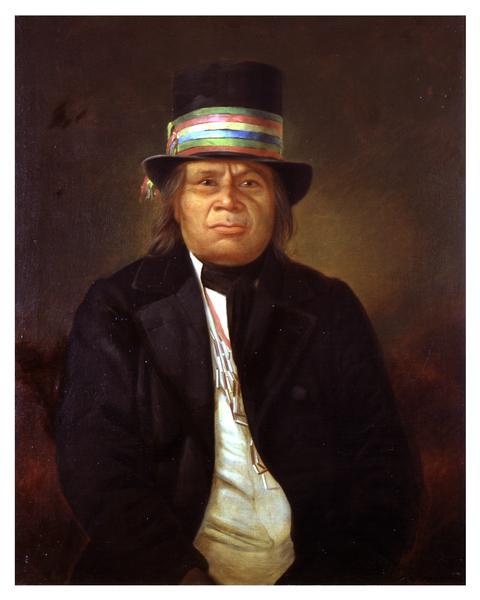When many years ago Oshkosh, now the second city in Wisconsin, was a hamlet of a few scattered wooden houses along the beautiful forest banks of the deep, wide Fox river, it was known by the classic name of Athens. An election being held to settle on a sure enough name for the future city, the river men, not so much in love with the ancient glory of the city of Athens as they were with the more appropriate name of the old head chief of the Menomonee, came partly in fun and some in earnest and casting the deciding vote gave the budding city the name that has made it known around the world.
Old Chief Oshkosh was entitled to the honor as he was a very worthy man. His worst enemy was his love for “fire water.” He was born in “The Old King’s” village one-half mile up river or south of the old French fort on the west bank of the Fox river, opposite the small settlement at Green Bay in 1795. Like all papooses, after he grew out of the basket cradle strapped to his mother’s back, he learned to fish and hunt with the bow and arrows. He was the grandson of Old King, but was not a chief until he became a warrior. When he came into the world the country about was owned by the Americans, but no government had been established over these tribes, except such as was accomplished by the fur trading Englishmen from Canada. The Americans had a small garrison in the old fort at Mackinaw island at the outbreak of the war of 1812.
Col. Robert Dickson organized a band of Wisconsin Indians, including the Menomonee under their chief, Tomah, with Oshkosh in the party. They proceeded by boats and canoes from Green Bay and easily captured the stockade without any less to either side. During the war the Americans could not repossess the fort. Colonel Dickson, with the Fox river Indians, including the Menomonee under Tomah defended the fort in a hard battle with the Americans to capture the stronghold in 1814. Major Holmes was killed by the Menomonee and a chief, Weekah, of the Menomonee was killed near the same spot. Oshkosh was with this garrison defending the fort and it was not the first real battle he had ever seen. Oshkosh went on the war path to join Tecumseh against Fort Meigs in 1813 and later under Proctor and Dickson attacked the fort Sandusky, so gallantly defended by Cropland; and every where defeating the Menomonee returned home to the Bay. Doubtless he was with the Menomonee war parties who frequently went out against the Chippewa in northern and western parts of the state.
“Oshkosh was of medium size, possessed much good sense and ability, but is a great slave to strong drink and two of his three sons surpass their father in this beastly vice” (Grignon). It was because of a brawl, occasioned by too much drink that he was laid up for a week and died at Keshena, August 20, 1858. The artist Brooks, reached Keshena a day or two before his death, and painted his picture, which hangs in the rooms o£ the Historical society at Madison. The artist lacked good taste in perpetuating this noble red man in the scarecrow clothing some wag had given him. Oshkosh in that plug hat and high colored ribbons may do for a comic almanac, but does scant justice to the supple form of the brave warrior of the Menomonee, who never raised the tomahawk against the white man.
When the Black Hawk war broke out in 1832 the Menomonee had been for many years enemies of the Ojibwa or Chippewa, but made peace with them, on the Chippewa river, encouraged to do so by their desire to join the Americans against the Foxes and Sacs. Colonel Stambough took about three hundred of them up river to join General Dodge’s rangers and frontiersmen protecting the settlers in that war.
Rev. Cutting Marsh saw this Menomonee band on their way up the Fox river and thus describes them:
“They appear, indeed, thoughtless as sheep bound to the slaughter. Their painted faces, ornaments, drums, whistles, war clubs and spears, made them appear, indeed, savage and scar-like. Their songs, uttered from their throat, consisting of deep guttural songs, and the occasional whoop was calculated to snake one feel darkness still brooded over this land removed so far from civilization.” Oshkosh was with them.
There were about sixty Menomonee under Colonel Hamilton, son of Alexander Hamilton, who carne up to the battle of Peckatonica just as it was over. The Winnebago took the scalps of the dead Sacs, but the Menomonee refused to take any, saying they belonged to the white chief, they had not killed them. One authority says of this Indian contingent, after a few days of talking, counseling and “eating up a great deal of beef, they became discontented and departed, frightening the inhabitants of the country through which they returned. They were a cowardly and treacherous set of miserable fellows.”
Oshkosh was present at the payment and treaty held by Governor Henry Dodge in 1836, at Cedar Point at Cedar Rapids, opposite Kimberly. At this treaty the Menomonee conceded a portion of their lands west of Lake Winnebago and Fox river, and were removed to Lake Poygan in town of Poygan in Winnebago county.


